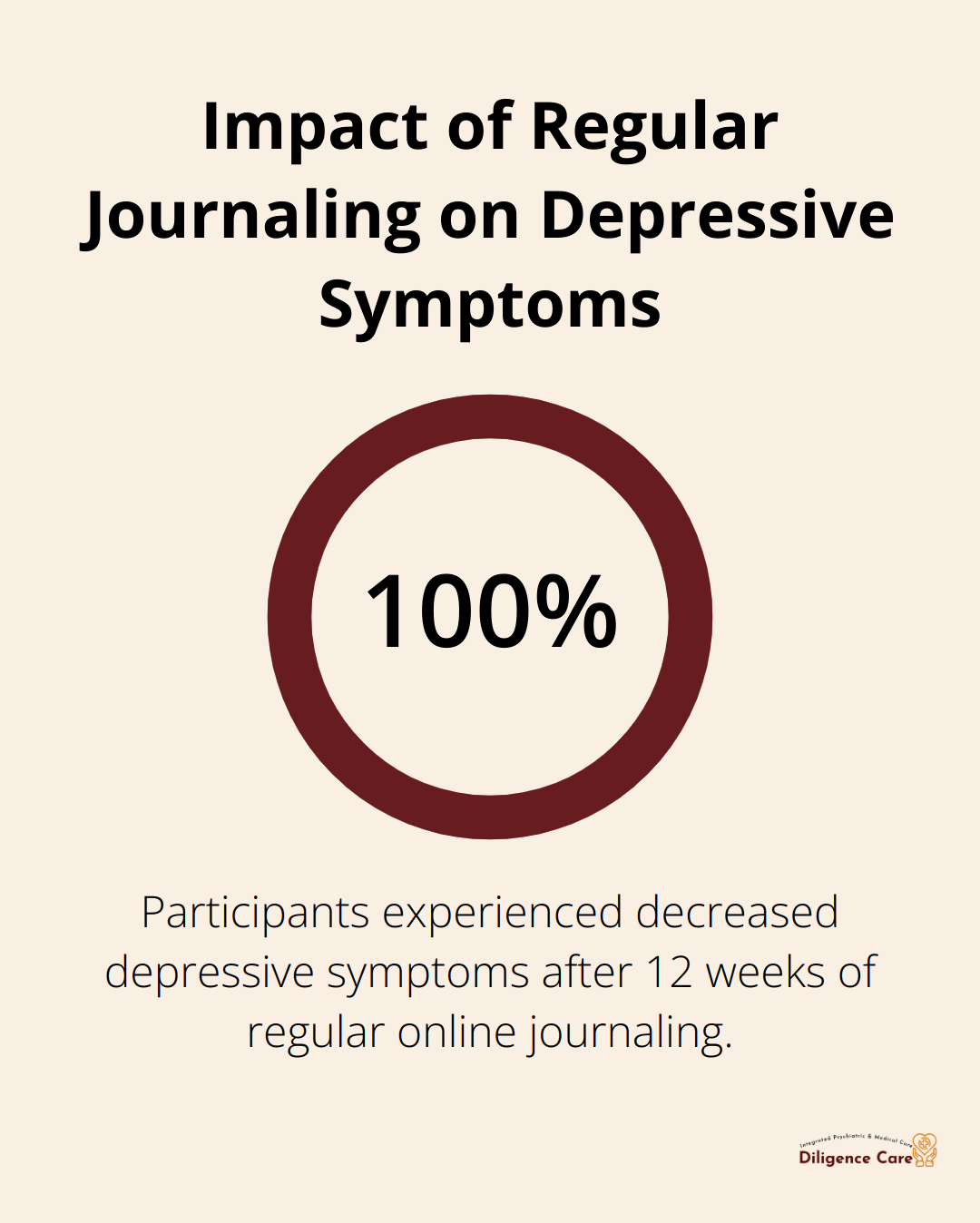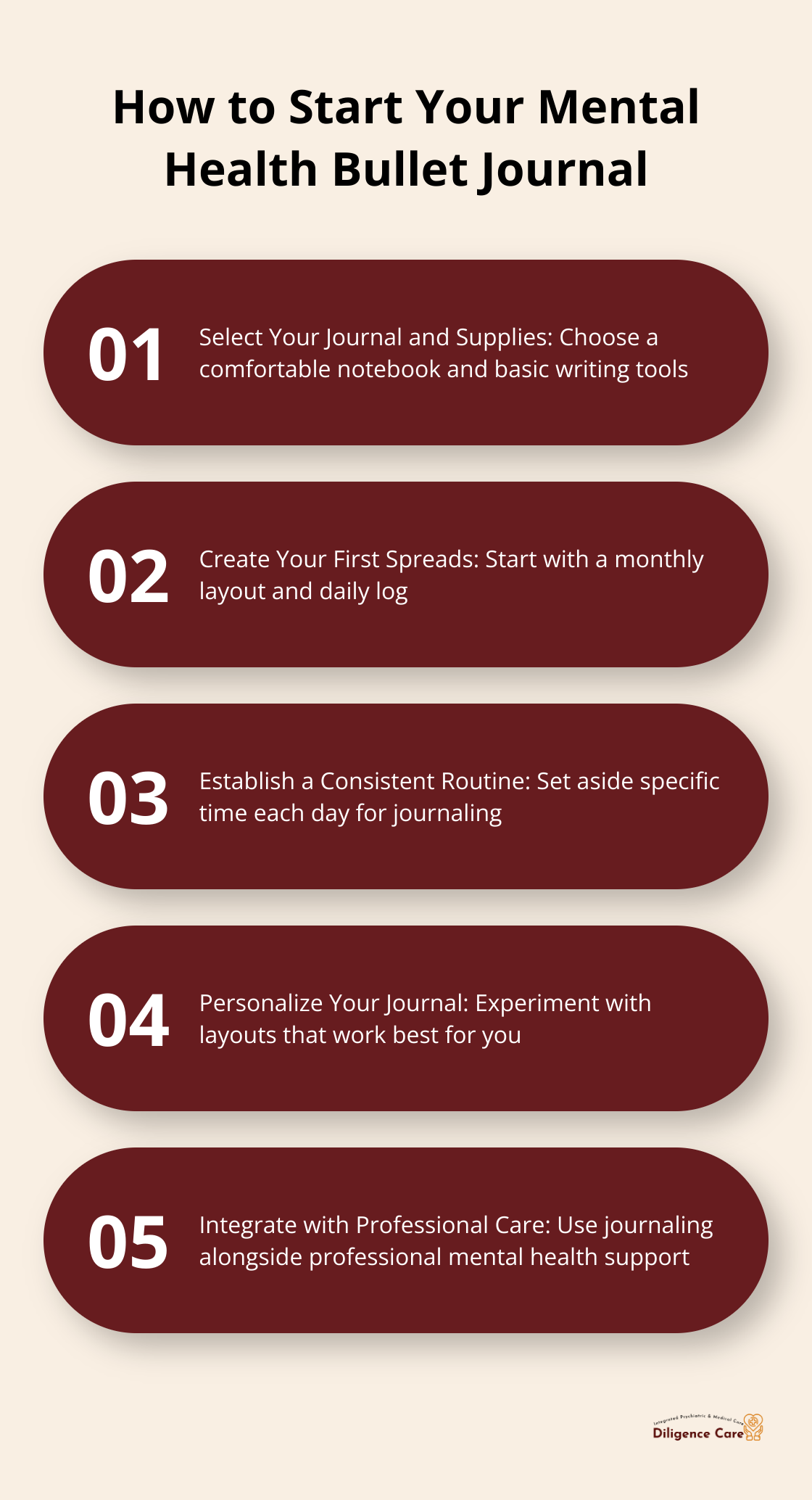
Mental Health Bullet Journaling for Self-Care
Mental health bullet journaling for self-care is a powerful tool for managing emotional well-being. This creative approach combines the structure of bullet journaling with focused mental health practices.
At Diligence Integrated Care, we’ve seen firsthand how this method can transform lives. By incorporating mood tracking, gratitude lists, and self-care planning into a personalized journal, you can gain valuable insights into your mental health journey.
What Is Mental Health Bullet Journaling?
Mental health bullet journaling combines organization with emotional awareness. This method tracks thoughts, feelings, and behaviors in a structured, visual way. Unlike traditional journaling, which often involves free-form writing, bullet journaling uses short-form notation, symbols, and creative layouts to capture information quickly and effectively.
The Power of Visualization
Mental health bullet journaling offers a key benefit: its visual nature. You can create mood trackers, habit charts, and goal-setting spreads to see patterns in your mental health over time. This visual representation helps identify triggers, recognize progress, and understand your emotional landscape.
Customization for Personal Growth
You can tailor your mental health bullet journal to your specific needs and goals. You might include pages for tracking medication, noting therapy insights, or planning self-care activities. This flexibility makes it an excellent complement to professional mental health care (such as the services offered at Diligence Integrated Care).
Mindfulness Through Practice
The act of bullet journaling itself can serve as a mindfulness practice. Taking time each day to reflect on your mental state and record your experiences helps cultivate self-awareness. This increased mindfulness can lead to better emotional regulation and stress management.
A study found that those with various medical conditions and anxiety who wrote online for 15 minutes three days a week over a 12-week period had decreased depressive symptoms. While this study focused on online journaling, the principles apply equally to bullet journaling.

Integration with Professional Care
Mental health professionals often recommend journaling as a complementary practice to therapy and medication management. It can enhance outcomes when incorporated into a mental health treatment plan. However, it’s important to note that mental health bullet journaling is a tool, not a replacement for professional care. If you struggle with mental health issues, seek help from qualified professionals.
As we move forward, let’s explore the key components that make up an effective mental health bullet journal. These elements will help you create a personalized tool for self-reflection and emotional growth.
Building Your Mental Health Toolkit
Mental health bullet journaling transforms thoughts into a personalized toolkit for emotional well-being. This approach proves effective when combined with professional care.

Tracking Moods and Emotions
A mood tracker forms the foundation of any mental health bullet journal. It visually represents your emotional state over time. You can use colors, symbols, or numbers to depict different moods. For instance, a scale of 1-10 might work, with 1 representing the lowest mood and 10 the highest.
Dr. Bolanle Oluwadara, MD, at Diligence Integrated Care often recommends mood tracking to patients. This practice helps identify patterns and triggers, making it easier to manage conditions like depression or anxiety.
Cultivating Gratitude and Positivity
Expressing gratitude may lead to higher happiness levels and increased wellbeing, which can be particularly beneficial for those struggling with depressive symptoms. Try writing three things you’re grateful for each day in your journal. You might also include a section for positive affirmations or mantras that resonate with you.
Setting and Tracking Goals
Goal-setting propels personal growth and mental health improvement. Create a spread for short-term and long-term goals in your bullet journal. Break these down into actionable steps. You can also use habit trackers to monitor daily behaviors that contribute to your goals.
For example, if you work with Bernadette Akpengbe, PMHNP-BC, FNP-BC at Diligence Integrated Care on managing anxiety, you might track daily meditation or exercise habits.
Planning Self-Care Activities
Self-care plays an essential role in mental health, yet often gets overlooked in our busy lives. Use your bullet journal to plan and track self-care activities. This could include exercise, reading, spending time in nature, or any activity that recharges you.
Eric Efuetngu, DNP, FNP-C, APRN at Diligence Integrated Care emphasizes the importance of regular self-care in managing mental health conditions. Your bullet journal can help you prioritize these activities and ensure they become a consistent part of your routine.
While bullet journaling offers a valuable tool, it works most effectively when used alongside professional care. If mental health issues challenge you, reach out to the team at Diligence Integrated Care for comprehensive, personalized support.
As we move forward, let’s explore practical tips to help you start your mental health bullet journaling journey. These strategies will set you up for success as you begin this transformative practice.
How to Start Your Mental Health Bullet Journal

Select Your Journal and Supplies
Choose a journal that fits your needs. Many prefer dotted notebooks for their versatility in writing and drawing. However, any notebook you feel comfortable with will suffice. Start with basic supplies: a good pen and perhaps some colored pencils or markers for mood tracking. This approach prevents overwhelm and allows you to focus on content rather than aesthetics.
Create Your First Spreads
Start with a simple monthly layout. Include a calendar for appointments and a mood tracker. For the mood tracker, assign colors to different emotions and fill in a small square each day. This visual representation helps identify patterns over time.
Next, design a daily log. This can be a simple to-do list with space for brief reflections. Include a gratitude section in your daily log to foster positivity (a practice often recommended by mental health professionals).
Establish a Consistent Routine
Consistency maximizes the benefits of mental health bullet journaling. Set aside a specific time each day for journaling, even if it’s just for five minutes. Many find it helpful to journal in the morning to set intentions for the day or in the evening to reflect on their experiences.
Try to link your journaling practice to an existing routine (like having your morning coffee or before going to bed) to increase consistency. If you miss a day, simply pick up where you left off. The act of returning to your journal is a form of self-care in itself.
Personalize Your Journal
Experiment with different layouts and trackers to discover what works best for you. The beauty of this method lies in its flexibility and adaptability to your unique needs and preferences. You might include pages for tracking medication, noting therapy insights, or planning self-care activities.
Integrate with Professional Care
While bullet journaling offers a valuable tool, it works most effectively when used alongside professional care. If mental health issues challenge you, reach out to a qualified mental health provider for comprehensive, personalized support. (Diligence Integrated Care offers a range of mental health services that can complement your journaling practice.)
Final Thoughts
Mental health bullet journaling for self-care empowers individuals to take control of their emotional well-being. This creative approach combines structured organization with focused mental health practices, resulting in a personalized tool for self-reflection and growth. The visual nature of bullet journaling helps users identify patterns, recognize progress, and gain deeper insights into their emotional landscape.
We encourage you to start your own mental health bullet journal today. Begin with simple spreads and basic supplies, then customize your journal to fit your unique needs and preferences. Establish a regular journaling routine that works for you to maximize the benefits of this practice.
While bullet journaling is a valuable self-care tool, it works best when combined with professional care. If you face mental health challenges, seek support from qualified professionals. Diligence Integrated Care offers comprehensive mental health services that can complement your journaling practice and help you navigate life’s challenges with greater resilience and self-understanding.











